Abstract
Indonesia is one of the most important centers for biodiversity in the world with the highest level of endemism. Meanwhile, tourism is one of the important and strategic economic sectors in the future. It is hoped that the development of the tourism industry will also be able to support efforts to conserve nature, biological wealth, and national cultural wealth. The identification and development planning of the tourism industry needs to be done in more detail and carefully. In this article, the identification and prediction model of support from the local government and the community in developing agro-tourism was proposed. The prediction model was built using the Adaptive Neuro-Fuzzy Inference System (ANFIS) method. Data were taken from 56 community members as respondents around the agro-tourism area. The results of modeling using the ANFIS method showed satisfactory results with an accuracy of 98.89%. The support of the local government and the surrounding community for the development of community-based agro-tourism is still considered not optimal. There needs to be a synergy between the two with various recommendations for more realistic development support.
1 Introduction
Indonesia is known as the lung of the world which has the most important biodiversity with the highest level of endemism. All of this natural and biological wealth is an invaluable asset so that it should be preserved. Conservation of nature and living resources in a sustainable manner in the long term is very important, because the preservation of life in the future depends on the preservation of nature and the environment. Various conservation efforts have been carried out by the government to protect this extraordinary natural wealth through various policies and cooperation with various groups of society, both national and international. Uncontrolled mining, logging and forest fires, improper land use change, pollution, and other causes are driving the accelerated destruction of nature and biodiversity. On the other hand, the need for tourism has become a necessity for all levels of the society. Besides being one of the important and strategic economic sectors, the development of the tourism industry is also expected to be able to support efforts to conserve nature, biological wealth, and the nation’s cultural wealth. The development of agro-tourism is one of the alternatives which is expected to be able to encourage both the regional economic potential and these conservation efforts.
Utilization and development of natural resource potential is still minimal and tends to be exploitative. This trend needs to be addressed immediately through the development of the tourism industry by planning and managing the potential, natural, and biological resources as an integrated area [1]. Limited resources are one of the factors for many of the natural potentials not being optimally exploited in various regions [2]. The development of natural and agro-tourism areas will be able to make a major contribution to local revenue, open business, and job opportunities as well as function to protect and preserve natural and biological resources [3]. Furthermore, the market demand for agro and natural tourism is huge and shows a significant increase worldwide. As an agricultural country with abundant natural resources, the development of the agro-tourism industry should play an important role in the future. Creativity and innovation, cooperation, and coordination as well as good promotion and marketing are required in the development of the agro-tourism. Moreover, area-based agro-tourism development also means the involvement of regional elements and communities intensively.
By sharing studies related to tourism, both potential planning and development have been widely carried out. Developing countries, especially tropical regions, are increasingly aware of the potential of natural resources in the development of community-based tourism [4]. Community-based tourism is an alternative to mass tourism in a sustainable tourism approach [5]. However, there must be an assessment of the successes and challenges of the community based tourism [6]. Sustainable community-based agro-tourism development is, in principle, a form of local community participation [7]. The development of environmentally friendly tourism activities that rely on natural resources is also a trend in the current tourism sector [8]. Agro-tourism in developing countries is also considered a tool for rural development and poverty alleviation [9]. The development of agro-tourism as a combination of the agricultural sector and the tourism sector can improve the welfare of farmers [10]. Agro-tourism has a positive impact on agricultural benefits [11]. The tourism sector also has a positive effect on socio-economic development in rural areas [12].
Agro-tourism as a community-based tourism activity that utilizes agricultural business as a tourist attraction can improve the community’s economy [13]. Business advancement in agro-tourism is a viable entrepreneurial solution for independent rural communities such as in Romania [14]. In conducting agro-tourism, it is also necessary to have an innovative combination of ecotourism, cultural tourism, and inclusive agriculture, making agricultural community farmers independent and sustainable [15]. In Indonesia, agro-tourism has the potential to be developed, and also, many regions of the Indonesian states have made agro-tourism businesses, including one that has the potential to be developed as agro-tourism with superior objects of salak, its processed products, unique culture, and beautiful hilly views in Karangasem, Bali [16]. Today, tourists are increasingly attracted to the mountainous natural destinations for reasons of climate, clean air, scenic beauty, local culture, history, and regional heritage [17]. In developing agro-tourism that needs attention, tourists hope that there will be facilities for adding knowledge and experience, a place to relax and a new atmosphere [18].
Priority attributes in agro-tourism development are marketing activities [19], as well as the importance of having a typology of strategies and policies based on customer groups [20]. However, agro-tourism still has challenges in its development related to institutions, sustainability, and competition such as tourism development in Bromo [21]. Not only challenges need attention but support from various parties is needed in agro-tourism. Sustainable and community-based tourism needs the support of stakeholders, be it local government, the private sector, or academics [22]. Local government policies through coordination play a very important role in the process of implementing tourism policies as has been done in Halmahera, this is an effort to increase community participation through partnerships for sustainable tourism, coordination of resources, and bureaucratic systems in tourism policy [23].
Panyaweuyan agro-tourism which is located in Majalengka Regency, West Java, State of Indonesia is one of the potentials that need to be developed, the attraction of natural scenery with beautiful terraces as a local cultural heritage has its own allure. Natural wealth is important in the tourism sector, so the development of agro-tourism has more potential for the promotion of local resource products [24], as well as tourism development in the agricultural production process is one alternative to agricultural diversification [25]. This is also expected for the development of Panyaweuyan agro-tourism. However, panyaweuyan still needs an in-depth study related to support for infrastructure, institutions, community participation, and the relationship between the existence of agro-tourism and the increase in income of the surrounding community which is not optimal. Thus, this study aims to analyze the form of support from the local government and the surrounding community in the development of agro-tourism in Panyaweuyan, the relationship with sustainability and its impact on the surrounding community, so that a model can be obtained that can support agro-tourism development from the point of view of government and community support.
This study focuses on making a simple model to predict the agro-tourism development level (very poor, poor, standard, good, very good) based on Community-based tourism (CBT) in the form of government support and community participation aspects. The model will use several other factors such as environmental conditions, society, government, and facilities. With the existing dynamic variables, modeling is carried out using a dynamic systems approach. The dynamic systems approach for prediction purposes has been widely used [26,27,28]. Therefore, it is expected that a dynamic systems approach can be used to predict agro-tourism development planning simply and with minimal error. In this article, the development of a predictive model from dynamic variables is carried out through a quantitative descriptive methodology using the Adaptive Neuro-Fuzzy Inference System (ANFIS) method. The ANFIS-based fuzzy method has been widely applied in various fields, such as predicting nutrient composition in the soil [29], predicting financial crisis forecasting performance [30], and various other applications. Although modeling for the prediction of a variable value has been studied using various statistical and computational approaches, some aspects of their dynamics are still obscure. Therefore, the aim of this study is to model an ANFIS to predict the agro-tourism development level based on CBT and to demonstrate the application of the model to identify nonlinear complex relationships between input and output variables.
2 Material and methods
The research was conducted in the Panyaweuyan agro-tourism area, which is located in the Agrapura District, Majalengka Regency. Panyaweuyan agro-tourism is a terraced area located at the foot of Mount Ciremai and is one of the agro-tourism objects that is getting a lot of attention from local, national, and even foreign tourists because of its natural beauty that is no less beautiful than the terraced areas in Bali.
The data used in this study are primary data and secondary data. The primary data used are data regarding the form of government and community support, hereinafter referred to as the input variable, and the panyaweuyan agro-tourism development variable, hereinafter referred to as the output variable. Meanwhile, secondary data used include data on the geographical location of the agro-tourism, review of literature from journals, and from other supporting sources. The data were then measured using a Likert scale from 1 to 5. The ratings were broken down from very positive to most negative.
Data collection techniques in this study were carried out through survey techniques by distributing questionnaires, as well as through interview techniques. The sampling of the research was carried out using purposive sampling technique on the community members around the Panyaweuyan agro-tourism area, who are members of the area manager and have a contribution to the development of Panyaweuyan agro-tourism. There were 56 respondents who were sampled in this study.
The analysis technique used for this research is descriptive quantitative method using the ANFIS method approach. The ANFIS system is an adaptive neural network based on a fuzzy conclusion system. The reasons for using ANFIS in this study are that it is easy to understand, very flexible, tolerates data that are considered inappropriate, is able to model nonlinear data, and can build and apply the experience of experts directly [31,32,33,34]. An ANFIS method has the advantage of modeling the qualitative side of human knowledge and the mechanism of the decision-making process through structured rules. Artificial neural networks also have the advantage of recognizing certain patterns, learning new things, and solving problems without the need to apply mathematical modeling. It can work based on historical data entered into it and can predict future events based on that data.
The variables used in this study consisted of two independent variables and one dependent variable. The independent variable consists of the government support variable and the community role variable, referred to as the input variable. While the dependent variable is the agro-tourism development level based on CBT, referred to as the output variable. The variables of government support and the role of the community are classified as input variables, because these two variables affect the variable of agro-tourism development level based on CBT, which is the output variable.
The government support variable in this study consists of two sub variables, namely management and promotion. Each of these sub variables consists of several indicators in the form of improvement on: community human resources quality, management capacity, accessibility, waste management, clean water facilities, and layout. Meanwhile, the promotion sub variable consists of three indicators: visit Panyaweuyan campaign, promotions in various media, and promotional synergies in various government agencies. In addition, for other input variables, namely, the community role variable consists of five indicators: community involvement in management, the presence of agro-tourism development initiators, decision-making authority, evaluation of the performance of managers by the community, and active participation in management. As for the agro-tourism development level based on CBT variable itself consists of 11 indicators, namely, the availability of other closed tourist objects, travel routes that connect the agro-tourism to other tourist objects, public/special transportation modes, souvenir centers, lodging, other supporting facilities (which are all provided by local communities), livelihoods of local people as farmers who carry out side jobs in the agro-tourism area, local communities’ ability as agro-tourism tour guides, empowerment programs to increase the tourism capacity of the local community, unique tourism products according to the characteristics of the local communities, and special organizations managing agro-tourism areas from the local community. The simplified description of those indicators for each variable (both input and output) is more clearly illustrated in Figure 1.
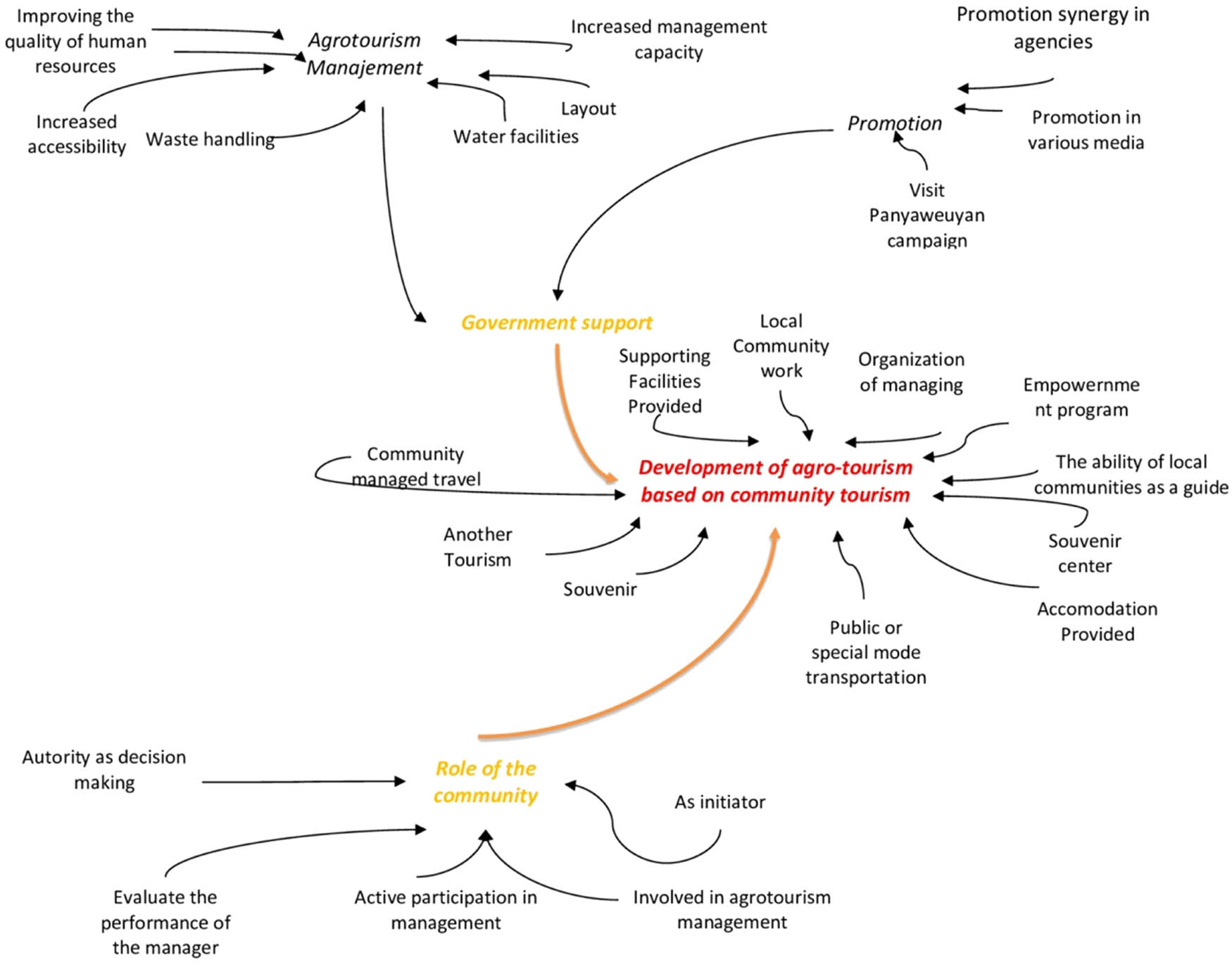
Causal diagram of input and output variables.
Modeling was performed using the ANFS method and designing several inputs and outputs that will be used in the analysis was carried out in accordance with Figure 1. The next stage is to make the desired range of values and naming each membership: government support [18,5,22], community role [18,22,35], and agro-tourism development level [15] for inputs and outputs, respectively. The ANFIS method which has a hybrid learning mechanism with a Gauss membership function for each input is used in this study. The results of the evaluation of the design show that the dataset used has 56 patterns. In addition, the efficiency of the proposed method is measured using a fourfold cross-validation test. At each time, one of the two subsets was used as the test set and the other two subsets were combined to form the training set. The advantage of using the method is that it does not depend on the data sharing process. Each data point will appear once and twice in the test and training sets, respectively. As a result, verification of the efficiency of the proposed method against the problem of over-learning can be overcome. Model validation was carried out using input/output datasets that were not previously involved in the training to select the ANFIS model. Validation is carried out on the results of the selected model to see the level of accuracy in predicting the output. The prediction model scheme using the ANFIS method is given in Figure 2.
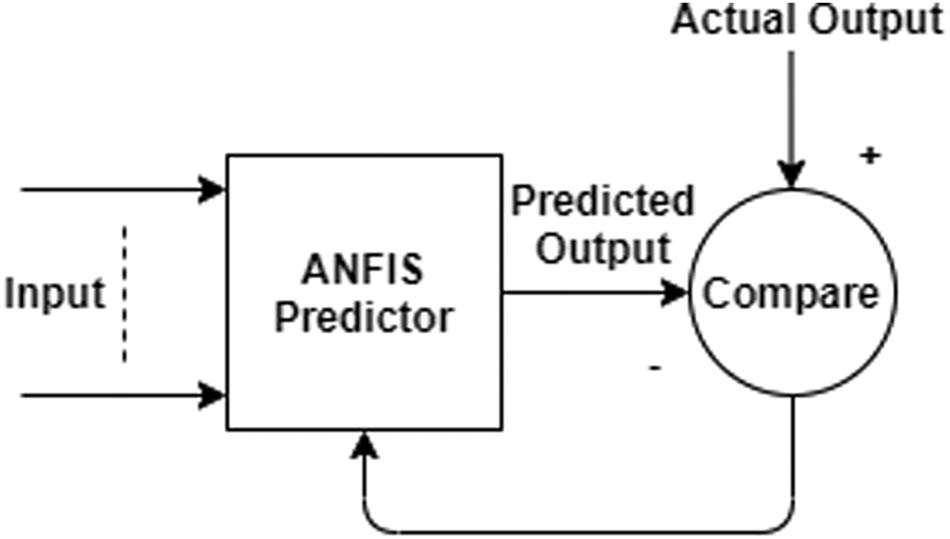
Proposed model block diagram.
3 Results and discussions
The development of the agro-tourism area demands a more comprehensive spatial management (spatial planning) which includes regulating, evaluating, controlling as well as reviewing the use of space as an agro-tourism area, from an ecological, economic, and socio-cultural perspective. The arrangement of this agro-tourism area is very likely to coincide with the use of other areas such as residential areas or industrial areas. Priorities need to be made by considering long-term interests. Therefore, in its development, a regional approach is needed that includes not only the ecological side but also the socio-cultural and economic aspects. So that in the long term, not only can the preservation of the carrying capacity of the environment be achieved, but also a stable economic growth and a sustainable culture. The direction and development strategy of the agro-tourism area must rely on local strengths and potentials and are market-oriented. The growth of the agro-tourism, like ecotourism market which is quite high in the world, requires creativity and innovation so as to be able to market unique local superior agro-tourism products. One of them is done by combining more general products such as developing adventure tourism, camping, developing hiking/tracking facilities, fishing, catering, cultural tourism, and others according to their potential.
In this regulation, the development of agro-tourism based on prediction models with the support of machine learning technology (a case study of Panyaweuyan agro-tourism) was carried out. It is hoped that the next prediction model can be used to assist the developer or government in more detail and direction without having to do research and re-survey. The prediction of agro-tourism development level which was obtained from the community and visitors can be used as an information and reminder as well. In modeling, the chosen machine learning method is the ANFIS. The training process at ANFIS is carried out in two steps, namely, a step forward and a step back. The forward step will generate parameter values fixing the consequent parameters at layer four using the Least Square Estimator (LSE). Meanwhile, the backward step will propagate the forward value back through backpropagation by using gradient descent to fix the premise parameter that is in layer one. Programming using the ANFIS method is trained in two classes, the maximum epoch is 40, the error is 10–6, and the learning rate ranges from 0.6 to 0.9. Figure 3 shows the results of the comparison of the sum square error whose momentum value is 0.9 and the learning rate ranges from 0.6 to 0.9. Based on Figure 3, the smallest RMSE value is 3.653 and it can be seen that the training plot (blue) follows the data testing (red) pattern. The small learning rate causes a larger number of epochs to achieve the same RMSE. Conversely, by determining a large learning rate, the required epoch becomes less. However, convergence that is too fast can result in the weight obtained not being the optimum global value so that the forecast results tend to be inaccurate.
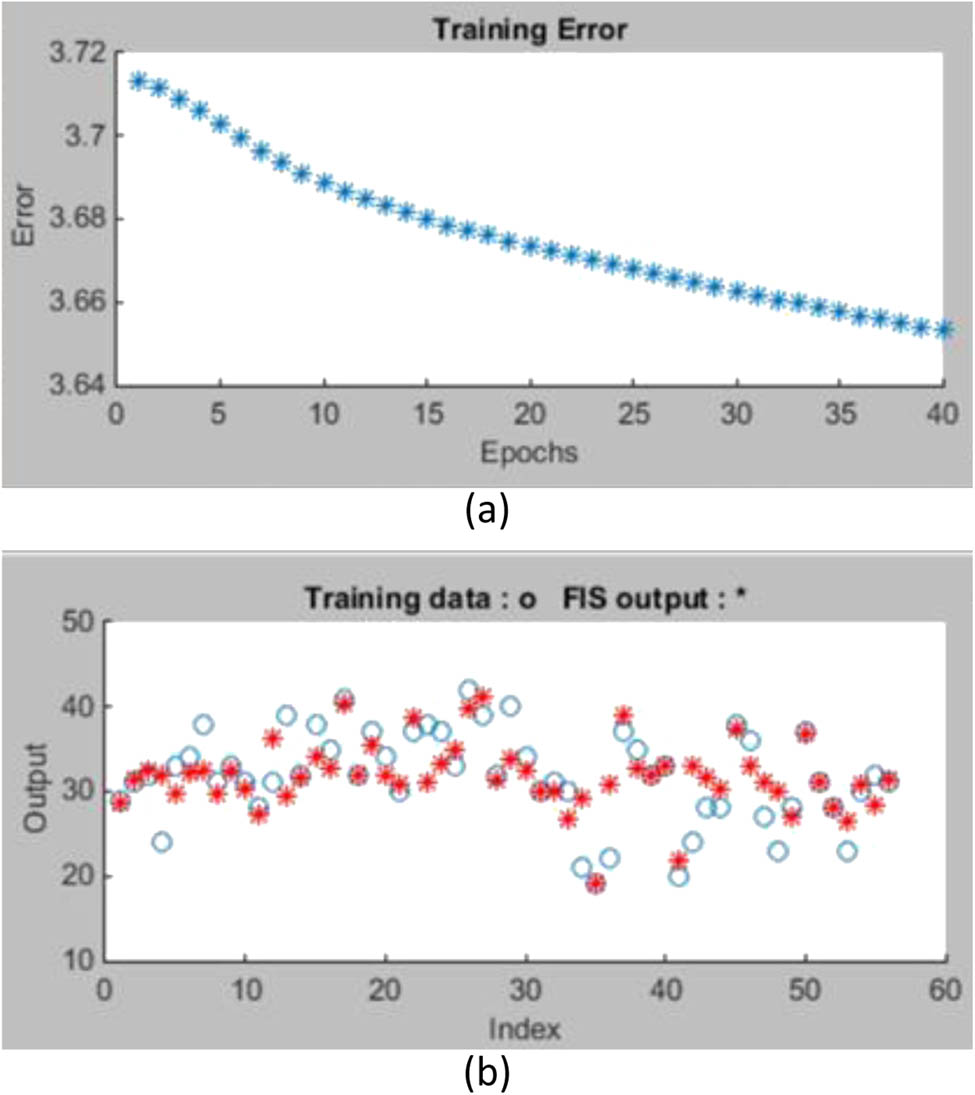
Training error and data: (a) training error, (b) plotting training (blue) and testing (red) data.
The agro-tourism model using the ANFIS method is built with two inputs and one output (Figure 4) with each of the variables having five classes (GS is government support, and SP is society participation). The five classes are: not supported (NS), less supported (LS), moderate (M), supported (S), and highly supported (HS). From the combination of two inputs to the class of each foreign variable, 25 rules are obtained as in Figure 5. The experiments that have been carried out have obtained the developed ANFIS model structure, namely 2 10 25 25 1 as in Figure 6. As is obvious from Figure 6, ANFIS has five primary layers: the principal layer is the data source which takes the boundaries and imports them to the model. This layer is additionally called as the information layer of the fluffy framework. The results of the main layer import to the subsequent layer and convey earlier upsides of participation capacities (MFs). Fluffy guidelines are closed from the hubs on second layer related level of action. The third layer standardizes the level of movement of any principles. The fourth layer takes on the hubs and capacity and produces the results and sends them to the result layer. The significant variables for deciding the exactness of the ANFIS is the number and kind of MFs, the ideal technique, and the resulting MF type. The input boundaries were autonomous factors (i.e., government supports and society interest) and the result variable was the agro-tourism travel industry improvement level. The ANFIS model was trained with Gaussian MFs as the best one from several selected MFs. The result enrolment work type chosen direct sort Because of its capacity to additionally decrease mistakes. Preparing of FIS was finished with backpropagation ideal strategy and 0 worth of blunder resistance.
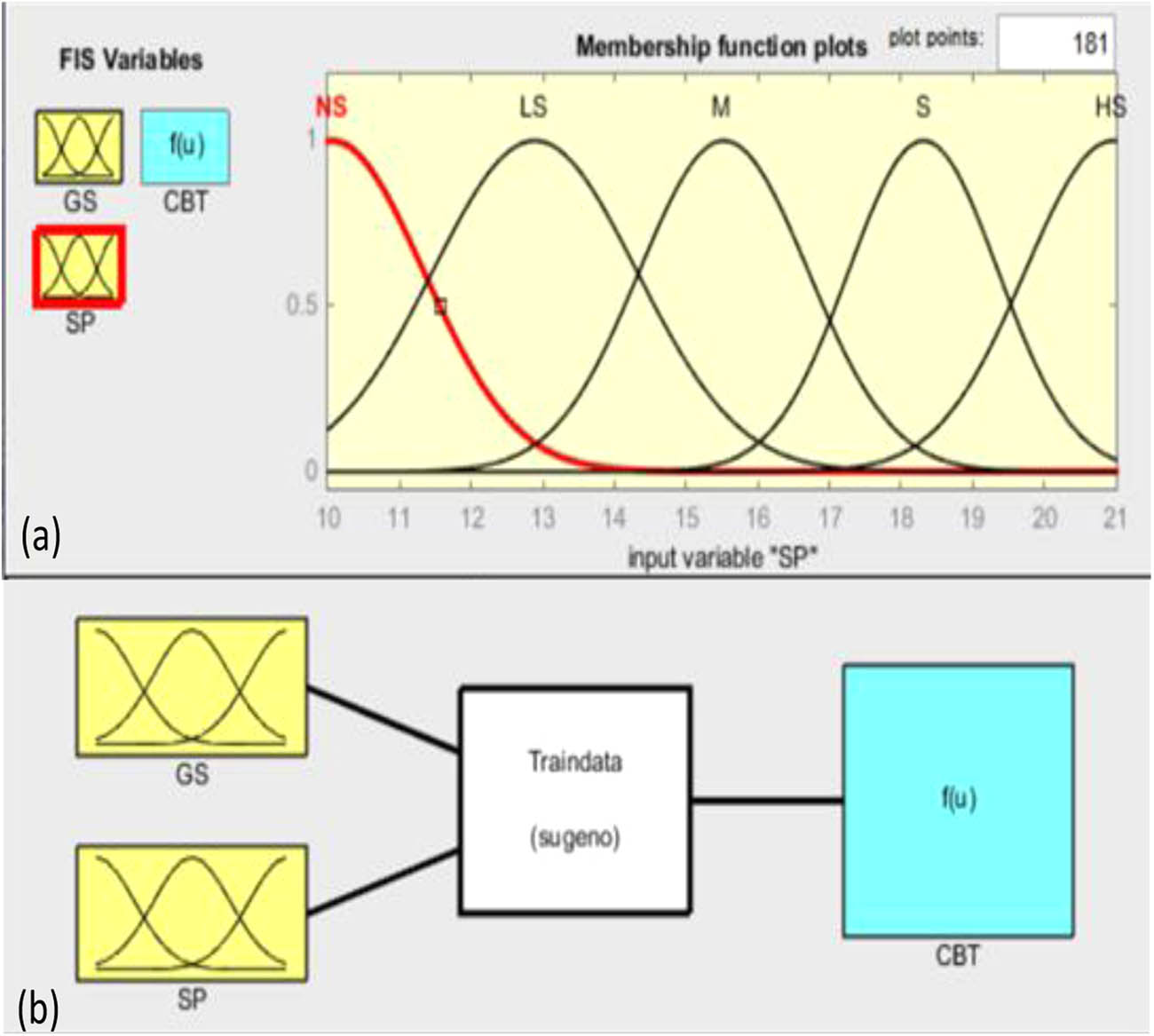
Input and out designs of ANFIS system.
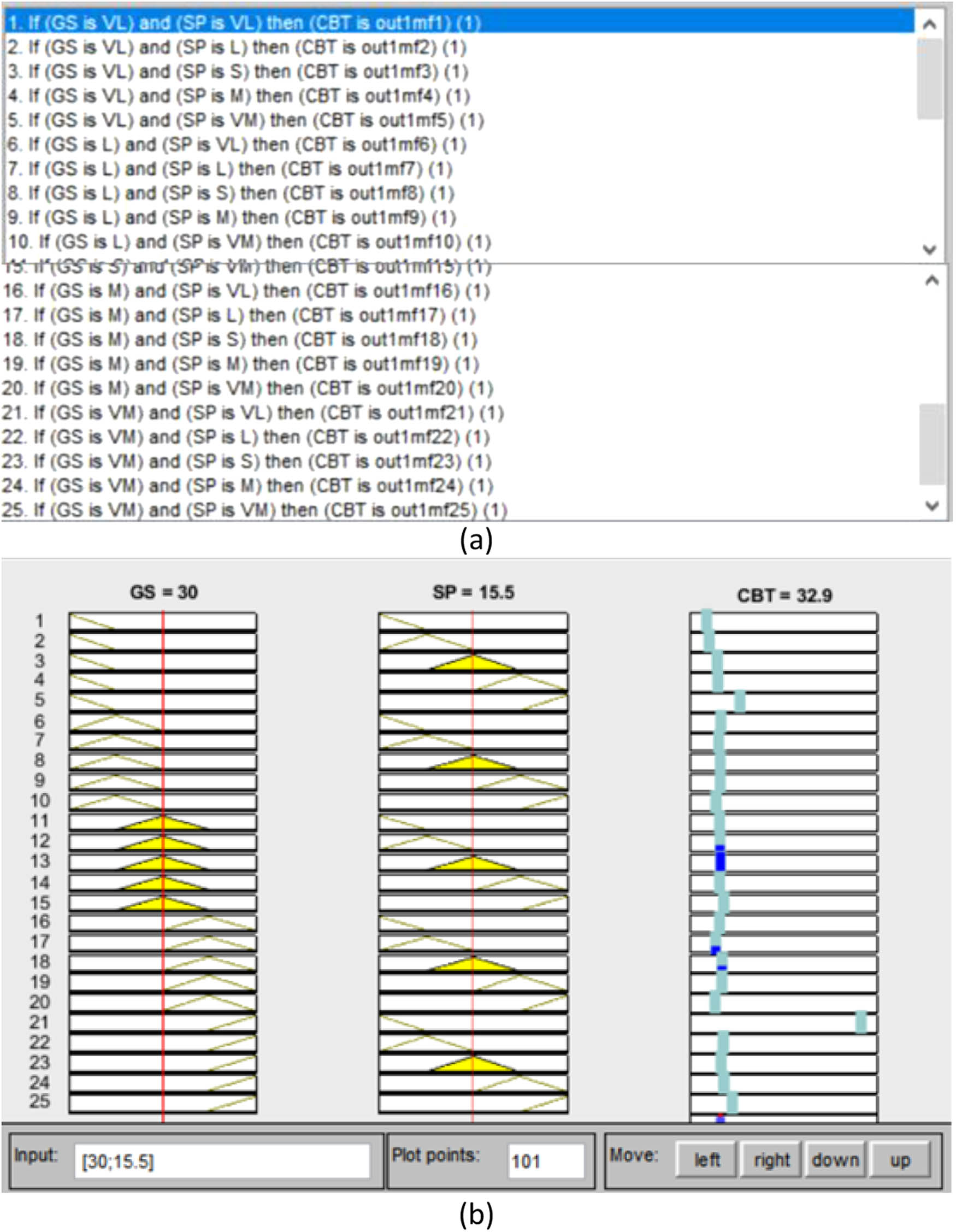
Developed rules: (a) 25 rules and (b) rules viewers.
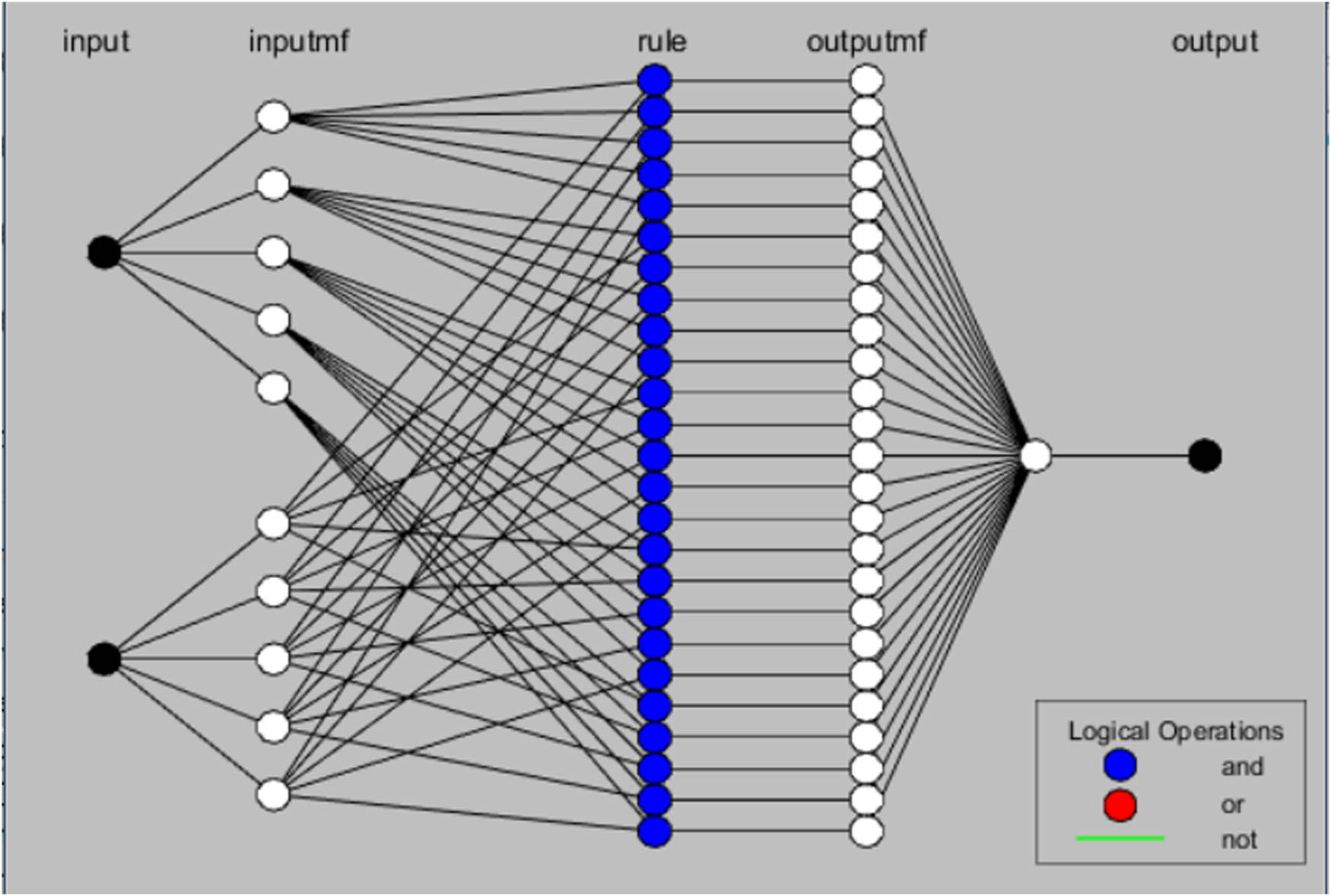
Struktur model ANFIS.
Next, is the prediction process based on the best data model from the learning process carried out by ANFIS, namely by using as many as two MFs. In this study, predictions were made for 26 respondents compared to the actual data available. From the results of these predictions, an accuracy value of 98.89% was obtained. The comparison of actual data with predictive data can be seen in Figure 7. From the graph of the comparison of the predictions between the actual data and the ANFIS test results, it can be seen that broadly the results of the determination by ANFIS are close to the actual values. Basically, forecasting with time series data with ANFIS will work well if the data used have a regular pattern. In this study, the data used had a pattern that had a statistically high enough deviation so that ANFIS actually gave an error at a certain point even though it was not too big.
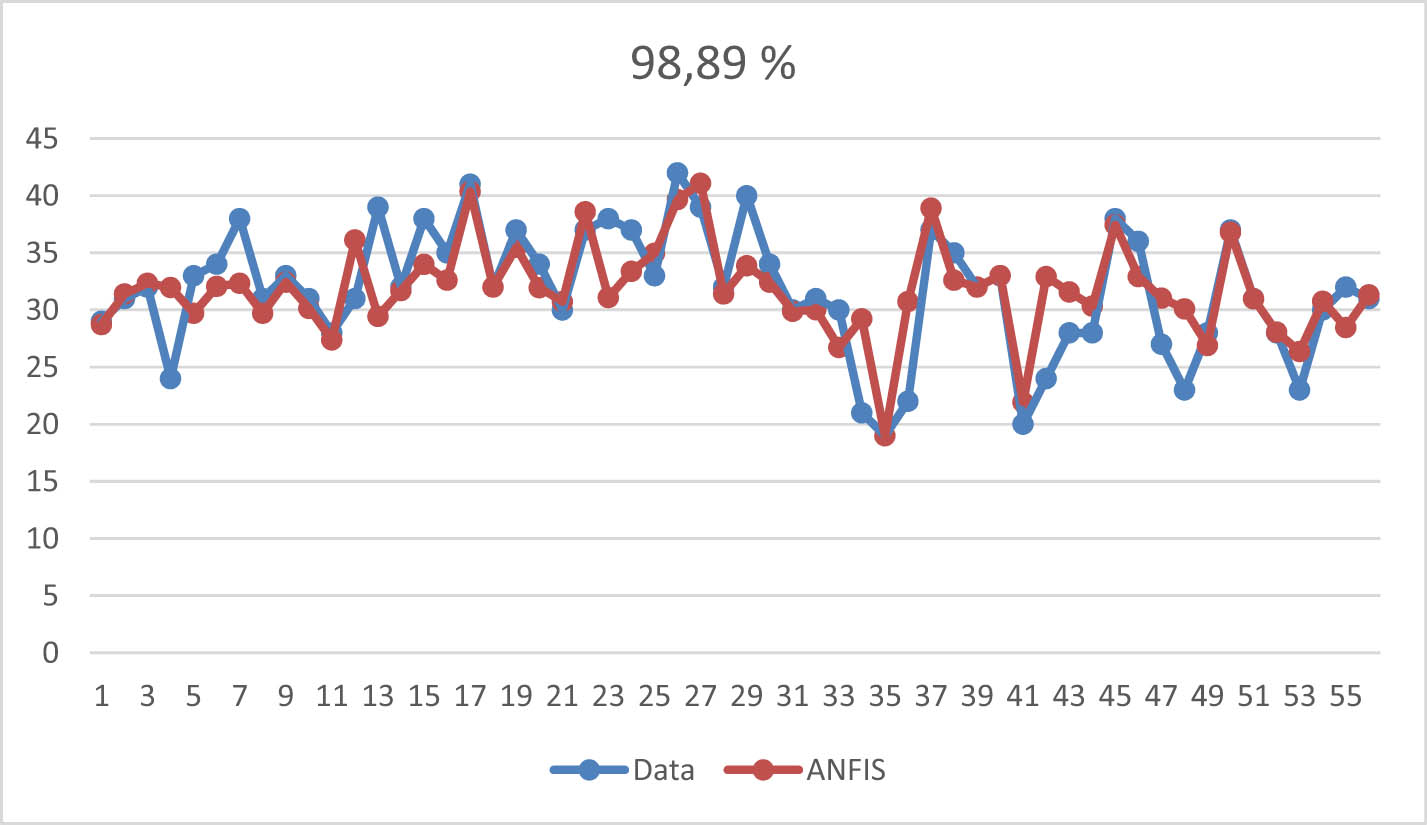
The comparison of actual and ANFIS predicted values for two Gaussian input membership functions.
The surface view for the optimum inputs and the output is shown in Figure 8. For instance, Figure 8 shows the relation between the government support, society support, and the Panyaweuyan Development level based on CBT. The surface view shows the degree of community effect on agro-tourism development level. For example, the society participation less than 16 level sharply affects the agro-tourism development level, then this effect is decreased to reach zero at the level less than 15. If the society participation is less than 14, it will have a negative correlation with the development level and if there are more than 11 it will have positive correlation with the development level.
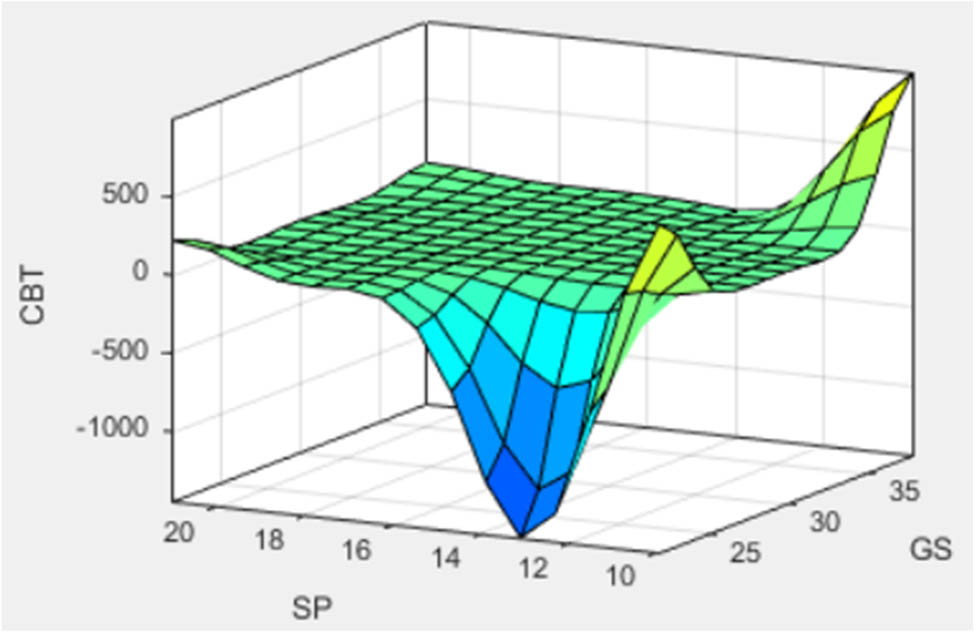
Surface viewer government support, society participation, and CBT based Panyaweuyan development.
Finally, data processing using ANFIS produces a predictive model from the questionnaire data. The prediction models based on ANFIS logic can be simulated by only providing input variables. Respondents are asked to evaluate based on nine questions related to the level of government support and five questions to indicate the level of community participation. Each question is given a range of ratings from numbers 1 to 5 which represent the level of satisfaction of the community or visitors. The data that are input are then accumulated into the value of the level of government support and community participation to get a conclusion in the form of agro-tourism development levels (very poor, poor, standard, good, very good) as indicated in Figure 9.
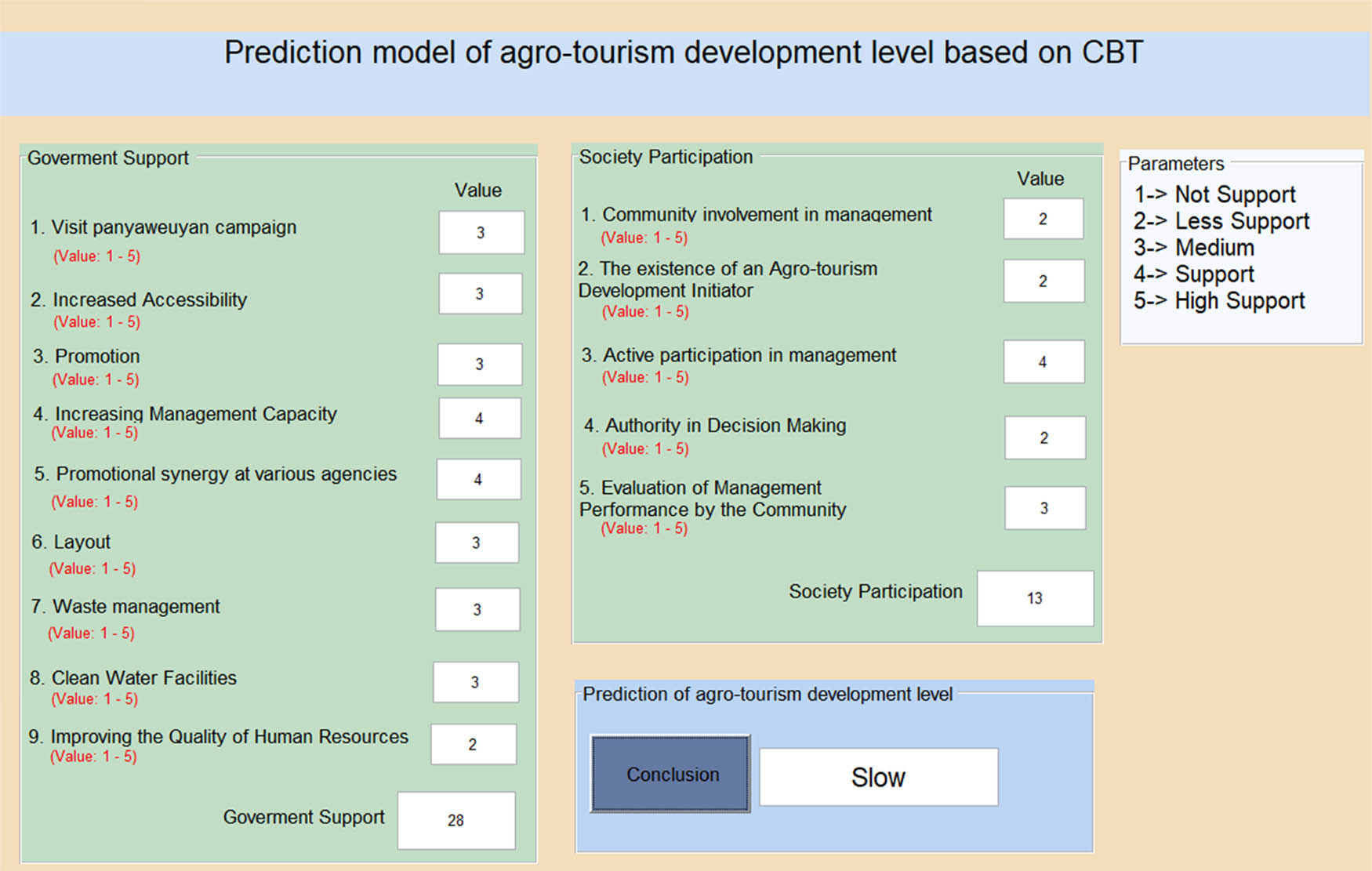
Developed prediction model of agro-tourism development level based on CBT.
From the results of the ANFIS analysis that has been carried out, it is found that the level of government support was very low, which means that the form of local government support for the development of Panyaweuyan agro-tourism is still considered low or lacking. This is in line with the results of the respondents’ assessments who consider that the form of local government support is still low for Panyaweuyan agro-tourism. According to the phenomenon in the field, local governments are still not optimal in integrating tourist areas with one another. As a result, every tourist who comes tends not to make repeated visits because the Panyaweuyan agro-tourism location is considered quite far from the main road, especially from the district city center. Furthermore, promotional activities are also considered to be still not optimal. Promotions carried out by the local government are still limited in certain environments and have not been comprehensive or are limited to visiting campaigns, and integrated promotions in government agencies through the installation of paintings or panyaweuyan terraced images on the attributes and activities held by the local government are in a limited scope. As a result, there are still many people who do not know the charm of the beauty of this Panyaweuyan agro-tourism. So far, the promotion of Panyaweuyan agro-tourism is still mostly carried out by loggers, bloggers, or social media activists. Apart from that, another assessment indicator is the increase in the capacity and quality of human resources which are still not visible. This can be seen from the inadequate development activities and management training programs carried out by the government for the community, especially managers through related agencies. In addition, the provision of clean water facilities at the research location is also considered to be inadequate. The technology for providing clean water for the local community, especially the sustainability of agricultural crop cultivation activities at the location, still applies the conventional system through the pipeline network only. However, regarding increase the accessibility of road facilities, it has begun to be addressed marked by the road facilities to the agro-tourism location that are starting to be good compared to few years ago when Panyaweuyan agro-tourism was known only to the community. In order to attract more tourists, by taking into account the condition of the contours of the local area, the local government is considered necessary to increase various kinds of support for the development of agro-tourism in Panyaweuyan, starting from improving the integration of tourism areas, carrying out promotional strategies, increasing the capacity and quality of human resources, one of which is through training activities and provision to the procurement of tourism schools, to the touch of the right technology to be able to handle things that are considered crucial in agro-tourism locations, such as the provision of clean water facilities. Of course, this is very necessary to be done and addressed for the sustainability of Panyaweuyan agro-tourism and improving the economy of the community as well as the area.
Furthermore, the ANFIS analysis results for community role variables show that the role of the community for the development of panyaweuyan agro-tourism was in the low category. The involvement of local communities in agro-tourism management (initiator, management decision making, and management evaluator) is still not maximal. The community is considered to be too focused on farming activities only, even though the existence of the panyaweuyan agro-tourism area is considered very potential in increasing the income of the community, most of whom are agricultural business actors. The existence of the panyaweuyan agro-tourism area can actually be a means for the farmers to be able to develop their products into various kinds of unique preparations as souvenirs. In addition, farmers can also become tour guides, of course, with a level of understanding of farmers in farming activities, they can be used as basic provisions. Local people or local communities who work as breeders can also provide public or special transportation services (sheep, goats, or horses), lodging service providers, and others to increase community income. The involvement of the local community, especially farmers in the Panyaweuyan agro-tourism area, is limited to trading activities, parking managers, land providers, and leek farming managers.
The results of the analysis of the output variable, namely, the development of community-based agro-tourism, show that the development of community-based agro-tourism in the panyaweuyan agro-tourism location is still in the low category. In line with the results of research in the field, there is no public awareness of the maximum management of panyaweuyan agro-tourism due to the absence of education on the importance of integrated agriculture and tourism from related parties. The limited human resources are one of the main triggers for the slow development of the community-based panyaweuyan agro-tourism. The local community was considered unable to make breakthroughs in managing and utilizing the available resources. For example, the local community has not been able to integrate the existing tourist areas around Panyaweuyan agro-tourism, even though this is one strategy to attract more visitors. The existence of an integrated tour package offered will certainly be a special attraction for tourists who come. Travel that is far from the main road access, will be paid for by the presence of many tourist locations at the destination. In addition, people, especially farmers, have not been able to take advantage of their agricultural products, even though the agricultural potential in the region is very abundant. There is no provision for accommodation locations managed by the community (home stay). This is very potential to be developed and can be an additional income for people who are majority farmers. So as to improve the community’s ability in the management of this panyaweuyan agro-tourism, it is necessary to have community empowerment activities carried out by the local government. Good cooperation between the government and the community is considered very necessary for the development of this Panyaweuyan agro-tourism area in the future, besides of course improving the economic conditions of the local community, and to increase the beauty and comfort of tourists who come to visit.
4 Conclusion
Government support and local community participation in the development of Panyaweuyan agro-tourism are still considered not optimal. For that, a synergistic effort between the government and the surrounding community based on a sustainable society is needed. Recommendations for support between the two must be realistic with the contour conditions of the panyaweuyan in supporting the development of agro-tourism areas. Based on the study results, it is concluded that to predict the agro-tourism development level based on CBT of Panyaweuyan, it can be done using the ANFIS method as a matching tool with the trained variable values. From the testing results of the input data, the application has an overall success rate of 98.89%. With this application, the Panyaweuyan agro-tourism development level can be easily predicted or estimated based on the input variable values that are set with the ANFIS logic without having to retrieve data.
Acknowledgments
This research fund was obtained from a consortium of the Regional Development Planning, Research and Development Agency of Majalengka Region with Universitas Majalengka and Universitas Padjadjaran, Indonesia.
-
Funding information: This research was financed by a consortium of the Regional Development Planning, Research and Development Agency of Majalengka Region with Universitas Majalengka and Universitas Padjadjaran, Indonesia.
-
Conflict of interest: Sri Ayu Andayani and Arjon Turnip, who are the co-authors of this article, were Guest Editors of Open Agriculture. This fact did not affect the peer-review process.
-
Data availability statement: The datasets generated during and/or analyzed during the current study are available from the corresponding author on reasonable request.
References
[1] Candrea A, Ispas A. Visitor management, a tool for sustainable tourism development in protected areas. Bull Transilv Univ Brasov Ser V Econ Sci. 2009;2:51.Search in Google Scholar
[2] Lampert A. Over-exploitation of natural resources is followed by inevitable declines in economic growth and discount rate. Nat Commun. 2019;10:1419. 10.1038/s41467-019-09246-2.Search in Google Scholar
[3] Torres R. Linkages between tourism and agriculture in Mexico. Ann Tour Res. 2003;30:546–66.10.1016/S0160-7383(02)00103-2Search in Google Scholar
[4] Yanes A, Seweryn Z, Marlenny DC, Seong IK. Community-based tourism in developing countries: a framework for policy evaluation. J Sustain. 2019;11:2–506. 10.3390/su11092506. www.mdpi.com/journal/sustainability.Search in Google Scholar
[5] Dodds R, Alisha A, Kelly G. Mobilizing knowledge: determining key elements for success and pitfalls in developing community-based tourism. J Curr Issues Tour. 2018;21:13. 10.1080/13683500.2016.1150257.Search in Google Scholar
[6] Zielinski S, Seong IK,Camila B, Andrea Y. Factors that facilitate and inhibit community-based tourism initiatives in developing countries. J Curr Issue Tour. 2020;23:6. 10.1080/13683506.2018.1543254.Search in Google Scholar
[7] Kusuma DW, Murwani DF, Brawijaya AS, Witjaksono M. Development of agro-tourism through community organizing of tourism village. Eur J Econ Fiancial Res. 2017;2:2.Search in Google Scholar
[8] Sadowski A, Monika MW. Geographic differentiation of agritourism activities in Poland vs cultural and natural attractiveness of destinations and district level. PLoS One. 2019;14(9):E0222576. 10 1371/journal-pone-0222576.Search in Google Scholar
[9] Bhatta K, Keishiro I, Yasuo O. Determinant factors of farmers willingness to start agritourism in rural Nepal. J Open Agric. 2019;4(1):431–65. 10.1515/opag.2019.0043.Search in Google Scholar
[10] Utama IGBR, Christimulia PT. Buyan Tamblingan agrotourism ethical planning in forest conservation border areas. Proceedings of The 1st International Conference of Global Education and Society Science. Medan, Nort Sumatera, Indonesia: ICOGESS; 14 March 2019.Search in Google Scholar
[11] Barbieri C, Christine T. Perceived impact of agritourism on farm economic standing sales and profits. Travel and tourism research association advancing tourism research globaly; 2016. p. 34. https://scholarworks.unassedu/ttra/2010/oral/34.Search in Google Scholar
[12] Tleubayeva A. Rural tourism as one of the priority factors for sustainable development of rural territories in Kazakhstan. J Environ Manag Tour. Fall 2018;9(6(30)):1312–26.10.14505//jemt.v9.6(30).21Search in Google Scholar
[13] Pangestuti A, Latifah H, Lestari EW. Development of agrotourism potentiality in Kampung Kopi Amadanon, Malang. J Indonesian Tour Dev Stud. 2018;6:3. https://jitade-ub.ac.id. P.ISSN: 2355-3979, e.ISSN: 2338-1647.10.21776/ub.jitode.2018.006.03.06Search in Google Scholar
[14] Dragoi MC, Irina EL, Sebastian MM, Radu C, Ramona LT, Raluca GL. Incentives for developing resilient agritourism entrepreneurship in rural communities in Romania in a European context. J Sustain. 2017;9:12. 10.3390/su9122205.2017.Search in Google Scholar
[15] Norbu P, Sanjeeb KJ. Eco-organic tourism – a new era of sustainable agro entrepreneurship in Arunachal Pradesh. Srusti Manag Rev Bhubaneswar. 2019;12(1):40–8.Search in Google Scholar
[16] Sumantra K, Anik Y, Ketut S. Development of agrotourism to support community based tourism toward sustainable agriculture. Aust J Basic Appl Sci. 2017;11(13):93–9. 10.22587/ajbas-2017-11.13. ISSN: 1991-8178, EISSN:2309-8414. www.ajbds.web.com.Search in Google Scholar
[17] Saraswati AK, Prem R. Hill tourism and sustainable development of the destinations: a situation analysis of Kumaon region of Uttarakhand. Int J Mark Financial Manag. 2017 Jan;5(1):70–84. ISSN: 2348-3954 (online), ISSN: 2349-2546 (Print).Search in Google Scholar
[18] Iwayan RJ, Utama IG. Agrotourism as the economic transformation of the tourism village in Bali (Case study Blimbingsari Village, Jembrana. Bali J Bus Hosp Tour. 2016;2(1):26–40. ISSN 2527-9092.10.22334/jbhost.v2i1.37Search in Google Scholar
[19] Indrayanti T, Jamhari J, Jangkung HM, Masyhuri M. The customer satisfaction analysis of community based agrotourism in Yogyakarta. J Sustain Agric. 2020;35:1. ISSN: 2613-9456 (print) ISSN: 2599-2570 (online). jurnal.uns.ac.id/carakatani/article/view/29336.10.20961/carakatani.v35i1.29336Search in Google Scholar
[20] Haryono S, Gatot K, Zainal MEQ, Muafi M. Analysis of domestic tourist market. J Environ Manag Tour. 2017 Winter;VIII(8):24. 10.14505/jemt.V8.8(24).14.Search in Google Scholar
[21] Rosyidi MI. The challenges of developing tourism in BromoTengger Semeru of National Park. J Indonesian Tour Dev Stud. 2018;6(3):159–66. 10.21776/ub.jitode.2018.006.03.02. EISSN 2338.1647. http://jitode.ub.ac.id.Search in Google Scholar
[22] Dangi TB, Jamal T. An integrated approach to “Sustainable Community-Based Tourism”. Sustainability. 2016;8(5):475.10.3390/su8050475Search in Google Scholar
[23] Singgalen YA, Gatot S, Pamerdi GW. Tourism destination in remote area: problem and challenges of tourism development in North Halmahera as remote and border areas of Indonesia, Philippines. J Indonesian Tour Dev Stud. 2018;6(3):175–86. 10.21776/ub.jitode.2018-006-03-04. EISSN: 2338.1667. http://jitode.ub.ac.id.Search in Google Scholar
[24] Vukovic P, Marija MR. Potentials for development food tourism in AP Vojvodina in The Republic of Serbia. EKOHOMNKA. 2020 Jan–Mar;6(1):77–92. ISSN: 0350-137X, EISSN: 2334-9190 UDK 338.10.5937/ekonomika2001077VSearch in Google Scholar
[25] Vaugeois NL. Exposure-investment return continuum in Agritourism. TTRA Canada 2019 Conference 13; 2019. Retrieved from: https://scholar-works.umass.edu//ttracanada.2019.coneference/13.Search in Google Scholar
[26] Kusumandari D, Risqyawan M, Yazir M, Turnip M, Darma A, Turnip A. Application of convolutional neural network classifier for wireless arrhythmia detection. J Phys Conf Ser. 2018;1080:012048. 10.1088/1742-6596/1080/1/012048.Search in Google Scholar
[27] Turnip A, Turnip M, Dharma A, Paninsari D, Nababan T, Ginting CN. An application of modified filter algorithm fetal electrocardiogram signals with various subjects. Int J Artif Intell. 2020;18(1):207–17.Search in Google Scholar
[28] Turnip A, Ilham Rizqywan M, Kusumandari DE, Turnip M, Sihombing P. Classification of ECG signal with support vector machine method for arrhythmia detection. J Phys Conf Ser. 2018;970:012012. 10.1088/1742-6596/970/1/012012.Search in Google Scholar
[29] Ogunleye GO, Fashoto SG, Mashwama P, Arekete SA, Olaniyan OM, Omodunbi. BA. Fuzzy logic tool to forecast soil fertility in Nigeria. Sci World J. 2018;2018:3170816. 10.1155/2018/3170816.Search in Google Scholar PubMed PubMed Central
[30] Glovanis E. Study of discrete choice models and adaptive neuro-fuzzy inference system in the prediction of economic crisis periods in USA. Econ Anal Policy. 2012 Mar;42(1):79–96. 10.1016/S0313-5926(12)50006-8.Search in Google Scholar
[31] Turnip A, Simbolon AI, Amri MA, Suhendra MA. Utilization of EEG-SSVEP method and ANFIS classifier for controlling electronic wheelchair. International Conference on Technology, Informatics, Management, Engineering & Environment. IEEE; 2015. p. 143–6.10.1109/TIME-E.2015.7389763Search in Google Scholar
[32] Turnip M, Dharma A, Pasaribu HHS, Harahap M, Amri MF, Suhendra MA, et al. An application of online ANFIS classifier for wheelchair based brain computer interface. International Conference on Automation, Cognitive Science, Optics, Micro Electro-Mechanical System, and Information Technology. IEEE; 2015. p. 134–7.10.1109/ICACOMIT.2015.7440192Search in Google Scholar
[33] Turnip A, Amri MA, Suhendra MA, Kusumandari DE. Lie detection based EEG-P300 signal classified by ANFIS method. J Telecommun Electron Comput Eng. 2017;9(1–5):107–10.10.1145/3056662.3056709Search in Google Scholar
[34] Setiawan A, Yanto B, Yasdomi K. Logika fuzzy dengan Matlab (Contoh Kasus Penelitian Penyakit Bayi dengan Fuzzy Tsukamoto). Denpasar, Indonesia: Jayapangus Press; 2018. ISBN: 978-602-51483-7-8.Search in Google Scholar
[35] Vaugeois NP, Miles A, Doug B. Innovative and promising practices in sustainable tourism. VIURR Space; 2019. p. 1. World Leisure Centre of Excellence WLCE. https://viurrspace.ca/handle/10613/16372.Search in Google Scholar
© 2022 Sri Ayu Andayani et al., published by De Gruyter
This work is licensed under the Creative Commons Attribution 4.0 International License.
Articles in the same Issue
- Regular Articles
- Foliar application of boron positively affects the growth, yield, and oil content of sesame (Sesamum indicum L.)
- Impacts of adopting specialized agricultural programs relying on “good practice” – Empirical evidence from fruit growers in Vietnam
- Evaluation of 11 potential trap crops for root-knot nematode (RKN) control under glasshouse conditions
- Technical efficiency of resource-poor maize farmers in northern Ghana
- Bulk density: An index for measuring critical soil compaction levels for groundnut cultivation
- Efficiency of the European Union farm types: Scenarios with and without the 2013 CAP measures
- Participatory validation and optimization of the Triple S method for sweetpotato planting material conservation in southern Ethiopia
- Selection of high-yield maize hybrid under different cropping systems based on stability and adaptability parameters
- Soil test-based phosphorus fertilizer recommendation for malting barley production on Nitisols
- Effects of domestication and temperature on the growth and survival of the giant freshwater prawn (Macrobrachium rosenbergii) postlarvae
- Influence of irrigation regime on gas exchange, growth, and oil quality of field grown, Texas (USA) olive trees
- Present status and prospects of value addition industry for agricultural produce – A review
- Competitiveness and impact of government policy on chili in Indonesia
- Growth of Rucola on Mars soil simulant under the influence of pig slurry and earthworms
- Effect of potassium fertilizer application in teff yield and nutrient uptake on Vertisols in the central highlands of Ethiopia
- Dissection of social interaction and community engagement of smallholder oil palm in reducing conflict using soft system methodology
- Farmers’ perception, awareness, and constraints of organic rice farming in Indonesia
- Improving the capacity of local food network through local food hubs’ development
- Quality evaluation of gluten-free biscuits prepared with algarrobo flour as a partial sugar replacer
- Effect of pre-slaughter weight on morphological composition of pig carcasses
- Study of the impact of increasing the highest retail price of subsidized fertilizer on rice production in Indonesia
- Agrobiodiversity and perceived climatic change effect on family farming systems in semiarid tropics of Kenya
- Influences of inter- and intra-row spacing on the growth and head yield of cabbage (Brassica oleracea var. capitata) in western Amhara, Ethiopia
- The supply chain and its development concept of fresh mulberry fruit in Thailand: Observations in Nan Province, the largest production area
- Toward achieving sustainable development agenda: Nexus between agriculture, trade openness, and oil rents in Nigeria
- Phenotyping cowpea accessions at the seedling stage for drought tolerance in controlled environments
- Apparent nutrient utilization and metabolic growth rate of Nile tilapia, Oreochromis niloticus, cultured in recirculating aquaculture and biofloc systems
- Influence of season and rangeland-type on serum biochemistry of indigenous Zulu sheep
- Meta-analysis of responses of broiler chickens to Bacillus supplementation: Intestinal histomorphometry and blood immunoglobulin
- Weed composition and maize yield in a former tin-mining area: A case study in Malim Nawar, Malaysia
- Strategies for overcoming farmers’ lives in volcano-prone areas: A case study in Mount Semeru, Indonesia
- Principal component and cluster analyses based characterization of maize fields in southern central Rift Valley of Ethiopia
- Profitability and financial performance of European Union farms: An analysis at both regional and national levels
- Analysis of trends and variability of climatic parameters in Teff growing belts of Ethiopia
- Farmers’ food security in the volcanic area: A case in Mount Merapi, Indonesia
- Strategy to improve the sustainability of “porang” (Amorphophallus muelleri Blume) farming in support of the triple export movement policy in Indonesia
- Agrarian contracts, relations between agents, and perception on energy crops in the sugarcane supply chain: The Peruvian case
- Factors influencing the adoption of conservation agriculture by smallholder farmers in KwaZulu-Natal, South Africa
- Meta-analysis of zinc feed additive on enhancement of semen quality, fertility and hatchability performance in breeder chickens
- Meta-analysis of the potential of dietary Bacillus spp. in improving growth performance traits in broiler chickens
- Biocomposites from agricultural wastes and mycelia of a local mushroom, Lentinus squarrosulus (Mont.) Singer
- Cross transferability of barley nuclear SSRs to pearl millet genome provides new molecular tools for genetic analyses and marker assisted selection
- Detection of encapsulant addition in butterfly-pea (Clitoria ternatea L.) extract powder using visible–near-infrared spectroscopy and chemometrics analysis
- The willingness of farmers to preserve sustainable food agricultural land in Yogyakarta, Indonesia
- Transparent conductive far-infrared radiative film based on polyvinyl alcohol with carbon fiber apply in agriculture greenhouse
- Grain yield stability of black soybean lines across three agroecosystems in West Java, Indonesia
- Forms of land access in the sugarcane agroindustry: A comparison of Brazilian and Peruvian cases
- Assessment of the factors contributing to the lack of agricultural mechanization in Jiroft, Iran
- Do poor farmers have entrepreneurship skill, intention, and competence? Lessons from transmigration program in rural Gorontalo Province, Indonesia
- Communication networks used by smallholder livestock farmers during disease outbreaks: Case study in the Free State, South Africa
- Sustainability of Arabica coffee business in West Java, Indonesia: A multidimensional scaling approach
- Farmers’ perspectives on the adoption of smart farming technology to support food farming in Aceh Province, Indonesia
- Rice yield grown in different fertilizer combination and planting methods: Case study in Buru Island, Indonesia
- Paclobutrazol and benzylaminopurine improve potato yield grown under high temperatures in lowland and medium land
- Agricultural sciences publication activity in Russia and the impact of the national project “Science.” A bibliometric analysis
- Storage conditions and postharvest practices lead to aflatoxin contamination in maize in two counties (Makueni and Baringo) in Kenya
- Relationship of potato yield and factors of influence on the background of herbological protection
- Biology and life cycle Of Diatraea busckella (Lepidoptera: Crambidae) under simulated altitudinal profile in controlled conditions
- Evaluation of combustion characteristics performances and emissions of a diesel engine using diesel and biodiesel fuel blends containing graphene oxide nanoparticles
- Effect of various varieties and dosage of potassium fertilizer on growth, yield, and quality of red chili (Capsicum annuum L.)
- Review Articles
- Germination ecology of three Asteraceae annuals Arctotis hirsuta, Oncosiphon suffruticosum, and Cotula duckittiae in the winter-rainfall region of South Africa: A review
- Animal waste antibiotic residues and resistance genes: A review
- A brief and comprehensive history of the development and use of feed analysis: A review
- The evolving state of food security in Nigeria amidst the COVID-19 pandemic – A review
- Short Communication
- Response of cannabidiol hemp (Cannabis sativa L.) varieties grown in the southeastern United States to nitrogen fertilization
- Special Issue on the International Conference on Multidisciplinary Research – Agrarian Sciences
- Special issue on the International Conference on Multidisciplinary Research – Agrarian Sciences: Message from the editor
- Maritime pine land use environmental impact evolution in the context of life cycle assessment
- Influence of different parameters on the characteristics of hazelnut (var. Grada de Viseu) grown in Portugal
- Organic food consumption and eating habit in Morocco, Algeria, and Tunisia during the COVID-19 pandemic lockdown
- Customer knowledge and behavior on the use of food refrigerated display cabinets: A Portuguese case
- Perceptions and knowledge regarding quality and safety of plastic materials used for food packaging
- Understanding the role of media and food labels to disseminate food related information in Lebanon
- Liquefaction and chemical composition of walnut shells
- Validation of an analytical methodology to determine humic substances using low-volume toxic reagents
- Special Issue on the International Conference on Agribusiness and Rural Development – IConARD 2020
- Behavioral response of breeder toward development program of Ongole crossbred cattle in Yogyakarta Special Region, Indonesia
- Special Issue on the 2nd ICSARD 2020
- Perceived attributes driving the adoption of system of rice intensification: The Indonesian farmers’ view
- Value-added analysis of Lactobacillus acidophilus cell encapsulation using Eucheuma cottonii by freeze-drying and spray-drying
- Investigating the elicited emotion of single-origin chocolate towards sustainable chocolate production in Indonesia
- Temperature and duration of vernalization effect on the vegetative growth of garlic (Allium sativum L.) clones in Indonesia
- Special Issue on Agriculture, Climate Change, Information Technology, Food and Animal (ACIFAS 2020)
- Prediction model for agro-tourism development using adaptive neuro-fuzzy inference system method
- Special Issue of International Web Conference on Food Choice and Eating Motivation
- Can ingredients and information interventions affect the hedonic level and (emo-sensory) perceptions of the milk chocolate and cocoa drink’s consumers?
Articles in the same Issue
- Regular Articles
- Foliar application of boron positively affects the growth, yield, and oil content of sesame (Sesamum indicum L.)
- Impacts of adopting specialized agricultural programs relying on “good practice” – Empirical evidence from fruit growers in Vietnam
- Evaluation of 11 potential trap crops for root-knot nematode (RKN) control under glasshouse conditions
- Technical efficiency of resource-poor maize farmers in northern Ghana
- Bulk density: An index for measuring critical soil compaction levels for groundnut cultivation
- Efficiency of the European Union farm types: Scenarios with and without the 2013 CAP measures
- Participatory validation and optimization of the Triple S method for sweetpotato planting material conservation in southern Ethiopia
- Selection of high-yield maize hybrid under different cropping systems based on stability and adaptability parameters
- Soil test-based phosphorus fertilizer recommendation for malting barley production on Nitisols
- Effects of domestication and temperature on the growth and survival of the giant freshwater prawn (Macrobrachium rosenbergii) postlarvae
- Influence of irrigation regime on gas exchange, growth, and oil quality of field grown, Texas (USA) olive trees
- Present status and prospects of value addition industry for agricultural produce – A review
- Competitiveness and impact of government policy on chili in Indonesia
- Growth of Rucola on Mars soil simulant under the influence of pig slurry and earthworms
- Effect of potassium fertilizer application in teff yield and nutrient uptake on Vertisols in the central highlands of Ethiopia
- Dissection of social interaction and community engagement of smallholder oil palm in reducing conflict using soft system methodology
- Farmers’ perception, awareness, and constraints of organic rice farming in Indonesia
- Improving the capacity of local food network through local food hubs’ development
- Quality evaluation of gluten-free biscuits prepared with algarrobo flour as a partial sugar replacer
- Effect of pre-slaughter weight on morphological composition of pig carcasses
- Study of the impact of increasing the highest retail price of subsidized fertilizer on rice production in Indonesia
- Agrobiodiversity and perceived climatic change effect on family farming systems in semiarid tropics of Kenya
- Influences of inter- and intra-row spacing on the growth and head yield of cabbage (Brassica oleracea var. capitata) in western Amhara, Ethiopia
- The supply chain and its development concept of fresh mulberry fruit in Thailand: Observations in Nan Province, the largest production area
- Toward achieving sustainable development agenda: Nexus between agriculture, trade openness, and oil rents in Nigeria
- Phenotyping cowpea accessions at the seedling stage for drought tolerance in controlled environments
- Apparent nutrient utilization and metabolic growth rate of Nile tilapia, Oreochromis niloticus, cultured in recirculating aquaculture and biofloc systems
- Influence of season and rangeland-type on serum biochemistry of indigenous Zulu sheep
- Meta-analysis of responses of broiler chickens to Bacillus supplementation: Intestinal histomorphometry and blood immunoglobulin
- Weed composition and maize yield in a former tin-mining area: A case study in Malim Nawar, Malaysia
- Strategies for overcoming farmers’ lives in volcano-prone areas: A case study in Mount Semeru, Indonesia
- Principal component and cluster analyses based characterization of maize fields in southern central Rift Valley of Ethiopia
- Profitability and financial performance of European Union farms: An analysis at both regional and national levels
- Analysis of trends and variability of climatic parameters in Teff growing belts of Ethiopia
- Farmers’ food security in the volcanic area: A case in Mount Merapi, Indonesia
- Strategy to improve the sustainability of “porang” (Amorphophallus muelleri Blume) farming in support of the triple export movement policy in Indonesia
- Agrarian contracts, relations between agents, and perception on energy crops in the sugarcane supply chain: The Peruvian case
- Factors influencing the adoption of conservation agriculture by smallholder farmers in KwaZulu-Natal, South Africa
- Meta-analysis of zinc feed additive on enhancement of semen quality, fertility and hatchability performance in breeder chickens
- Meta-analysis of the potential of dietary Bacillus spp. in improving growth performance traits in broiler chickens
- Biocomposites from agricultural wastes and mycelia of a local mushroom, Lentinus squarrosulus (Mont.) Singer
- Cross transferability of barley nuclear SSRs to pearl millet genome provides new molecular tools for genetic analyses and marker assisted selection
- Detection of encapsulant addition in butterfly-pea (Clitoria ternatea L.) extract powder using visible–near-infrared spectroscopy and chemometrics analysis
- The willingness of farmers to preserve sustainable food agricultural land in Yogyakarta, Indonesia
- Transparent conductive far-infrared radiative film based on polyvinyl alcohol with carbon fiber apply in agriculture greenhouse
- Grain yield stability of black soybean lines across three agroecosystems in West Java, Indonesia
- Forms of land access in the sugarcane agroindustry: A comparison of Brazilian and Peruvian cases
- Assessment of the factors contributing to the lack of agricultural mechanization in Jiroft, Iran
- Do poor farmers have entrepreneurship skill, intention, and competence? Lessons from transmigration program in rural Gorontalo Province, Indonesia
- Communication networks used by smallholder livestock farmers during disease outbreaks: Case study in the Free State, South Africa
- Sustainability of Arabica coffee business in West Java, Indonesia: A multidimensional scaling approach
- Farmers’ perspectives on the adoption of smart farming technology to support food farming in Aceh Province, Indonesia
- Rice yield grown in different fertilizer combination and planting methods: Case study in Buru Island, Indonesia
- Paclobutrazol and benzylaminopurine improve potato yield grown under high temperatures in lowland and medium land
- Agricultural sciences publication activity in Russia and the impact of the national project “Science.” A bibliometric analysis
- Storage conditions and postharvest practices lead to aflatoxin contamination in maize in two counties (Makueni and Baringo) in Kenya
- Relationship of potato yield and factors of influence on the background of herbological protection
- Biology and life cycle Of Diatraea busckella (Lepidoptera: Crambidae) under simulated altitudinal profile in controlled conditions
- Evaluation of combustion characteristics performances and emissions of a diesel engine using diesel and biodiesel fuel blends containing graphene oxide nanoparticles
- Effect of various varieties and dosage of potassium fertilizer on growth, yield, and quality of red chili (Capsicum annuum L.)
- Review Articles
- Germination ecology of three Asteraceae annuals Arctotis hirsuta, Oncosiphon suffruticosum, and Cotula duckittiae in the winter-rainfall region of South Africa: A review
- Animal waste antibiotic residues and resistance genes: A review
- A brief and comprehensive history of the development and use of feed analysis: A review
- The evolving state of food security in Nigeria amidst the COVID-19 pandemic – A review
- Short Communication
- Response of cannabidiol hemp (Cannabis sativa L.) varieties grown in the southeastern United States to nitrogen fertilization
- Special Issue on the International Conference on Multidisciplinary Research – Agrarian Sciences
- Special issue on the International Conference on Multidisciplinary Research – Agrarian Sciences: Message from the editor
- Maritime pine land use environmental impact evolution in the context of life cycle assessment
- Influence of different parameters on the characteristics of hazelnut (var. Grada de Viseu) grown in Portugal
- Organic food consumption and eating habit in Morocco, Algeria, and Tunisia during the COVID-19 pandemic lockdown
- Customer knowledge and behavior on the use of food refrigerated display cabinets: A Portuguese case
- Perceptions and knowledge regarding quality and safety of plastic materials used for food packaging
- Understanding the role of media and food labels to disseminate food related information in Lebanon
- Liquefaction and chemical composition of walnut shells
- Validation of an analytical methodology to determine humic substances using low-volume toxic reagents
- Special Issue on the International Conference on Agribusiness and Rural Development – IConARD 2020
- Behavioral response of breeder toward development program of Ongole crossbred cattle in Yogyakarta Special Region, Indonesia
- Special Issue on the 2nd ICSARD 2020
- Perceived attributes driving the adoption of system of rice intensification: The Indonesian farmers’ view
- Value-added analysis of Lactobacillus acidophilus cell encapsulation using Eucheuma cottonii by freeze-drying and spray-drying
- Investigating the elicited emotion of single-origin chocolate towards sustainable chocolate production in Indonesia
- Temperature and duration of vernalization effect on the vegetative growth of garlic (Allium sativum L.) clones in Indonesia
- Special Issue on Agriculture, Climate Change, Information Technology, Food and Animal (ACIFAS 2020)
- Prediction model for agro-tourism development using adaptive neuro-fuzzy inference system method
- Special Issue of International Web Conference on Food Choice and Eating Motivation
- Can ingredients and information interventions affect the hedonic level and (emo-sensory) perceptions of the milk chocolate and cocoa drink’s consumers?

